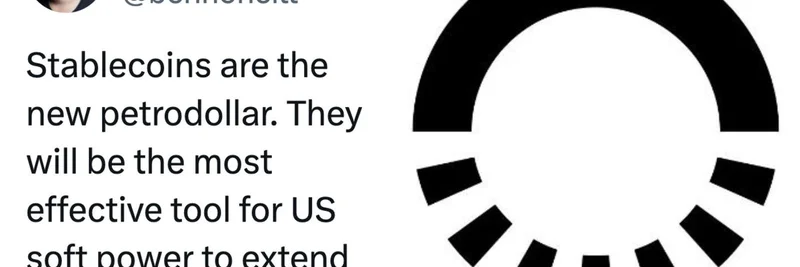In the fast-paced world of crypto, a bold statement from Ben O'Neill, co-founder of stablecoin infrastructure platform Bridge, is turning heads. As quoted in a recent post by Degenerate News on X, O'Neill declares: "Stablecoins are the new petrodollar. They will be the most effective tool for US soft power to extend into the 21st century."
This isn't just hype—it's a glimpse into how digital dollars are reshaping global influence, and yes, even the wild realm of meme tokens.
什么是石油美元?
If you're new to this, the petrodollar refers to the system where oil trades worldwide are settled in U.S. dollars. Established in the 1970s, it’s been a cornerstone of American economic dominance, ensuring constant demand for USD and giving the U.S. leverage in international affairs. Think of it as soft power on steroids— influencing without direct force.
Now, fast-forward to today. With stablecoins like USDT (Tether) and USDC (Circle's USD Coin), we're seeing a digital evolution. These are cryptocurrencies pegged 1:1 to the U.S. dollar, backed by reserves, and they move seamlessly across blockchains. No borders, no banks, just instant transfers.
稳定币作为数字石油美元
O'Neill's point? Stablecoins digitize dollar hegemony. In emerging markets, where traditional banking is spotty, people use stablecoins for remittances, savings, and trade. According to a Pantera Capital report, stablecoins handle over 50% of blockchain transactions and could unlock a trillion-dollar market.
This extends U.S. soft power because most major stablecoins are dollar-backed. Countries dodging sanctions? They still end up using USD via crypto. It's like the petrodollar but for the internet age—fueling everything from DeFi protocols to NFT drops.
But here's where it gets interesting for meme enthusiasts: stablecoins are the lifeblood of meme token trading.
与 Meme 代币的关联
Meme tokens, those viral, community-driven coins like Dogecoin or newer Solana-based gems, thrive on volatility. Traders buy in with stablecoins to hedge against crypto swings. On platforms like Jupiter or Raydium, you swap USDC for the latest pump-and-dump sensation.
Why does this matter? Stablecoins provide liquidity and stability in the meme ecosystem. Without them, meme trading would be a mess—imagine pricing your favorite cat coin in volatile ETH. Plus, as U.S.-backed assets, they subtly export American financial standards into the decentralized wild west.
Bridge, O'Neill's company, is pushing this further. They're building APIs for developers to integrate stablecoins effortlessly, aiming to become a top issuer by 2026. This could mean more efficient meme launches, cross-chain swaps, and yes, more U.S. influence baked into the tech.
挑战与前路
Of course, it's not all smooth sailing. Critics worry about stablecoin risks—like the 2022 TerraUSD collapse—and regulatory scrutiny. The U.S. is debating stablecoin laws to ensure they're safe, which could solidify their role as "digital petrodollars."
Meanwhile, alternatives like euro or yuan stablecoins are emerging, but USD ones dominate with over 85% market share, per recent reports.
For meme insiders, this means watching how regulations affect trading pairs. A stablecoin boom could supercharge meme volumes, but over-regulation might stifle innovation.
总结
Ben O'Neill's take isn't just a tweet—it's a roadmap for crypto's future. Stablecoins aren't memes themselves, but they're the infrastructure making meme magic possible. As they evolve into the new petrodollar, expect more U.S. soft power in your wallet, whether you're hodling DOGE or flipping the next big thing.
Stay tuned to Meme Insider for more on how blockchain trends intersect with meme culture. What's your take on stablecoins powering memes? Drop a comment below!



